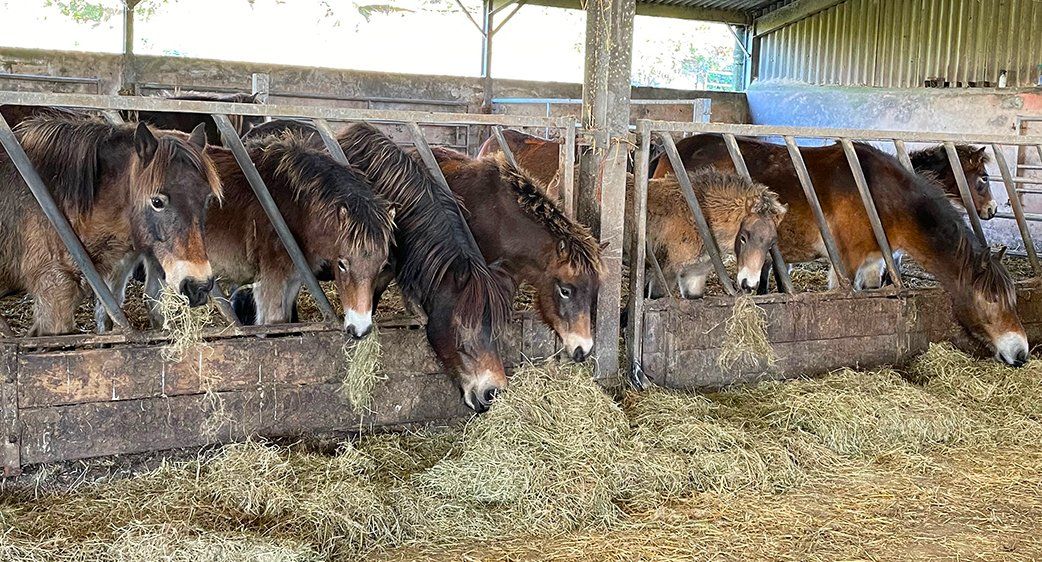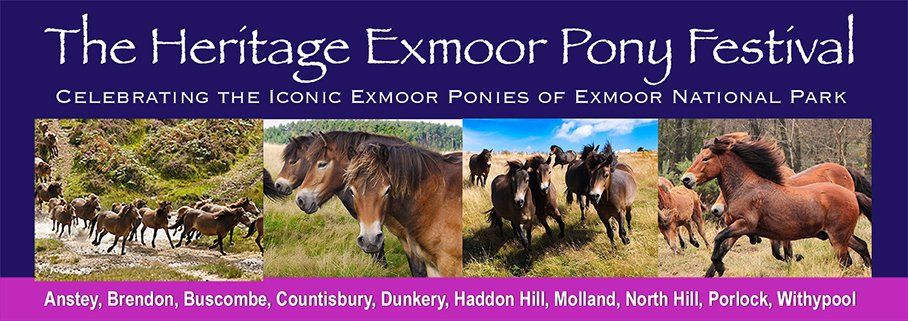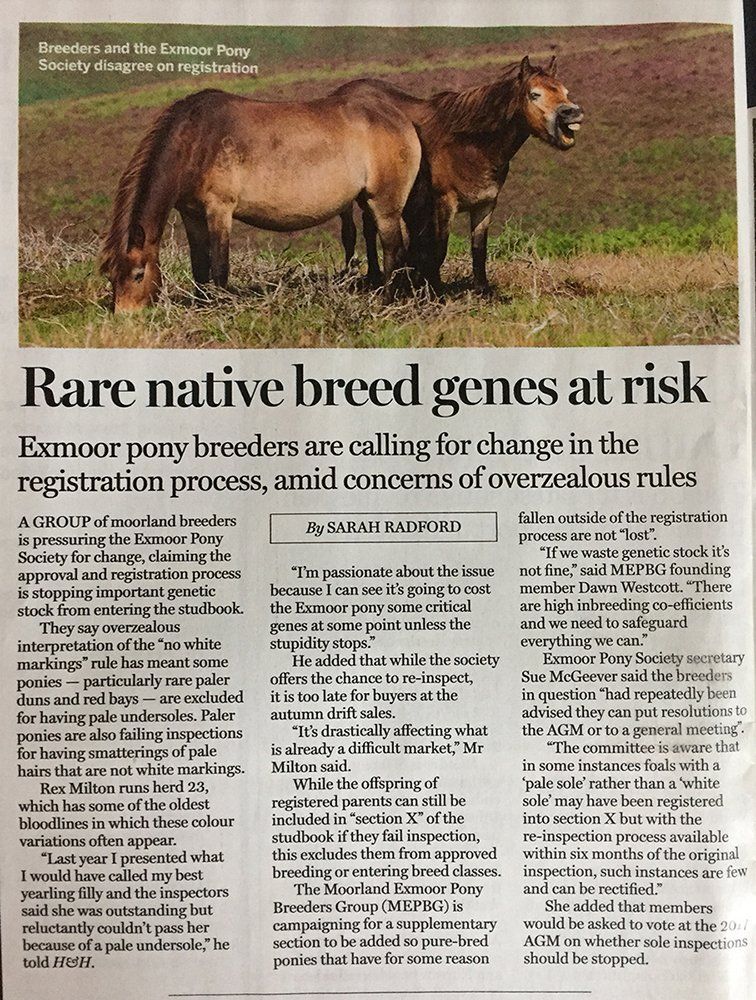


4 May 2017: UPDATE TO THIS BLOG and MEPBG statement:
Further to Emma Wallace's letter published in Horse & Hound (13 April 2017 issue), we would like to make the following information available to Exmoor pony breed supporters and the public:-
Emma Wallace's letter:
"Sir - With regard to whether Exmoors with pale undersoles should enter the studbook (news, 16 March; letters, 30 March), I wish to remind breed supporters that the trustees of the Exmoor Pony Society (EPS) do their best to support the breed as well as uphold the breed standard. My family are guardians of the Anchor herd that holds almost 25% of the entire Exmoor pony population's gene pool. We have managed and upheld the breed standard since World War II, as have other owners of free-living and "upcountry" bred ponies.
The Exmoor Committee of Herd Owners (ECHO) work to support breeders at gathering time and always managed to inspect even the wild moorland foals safely. I feel concerned that a threat of "criminal liability" was cited towards the trustees of the EPS by the chairman of the Moorland Exmoor Pony Breeders Group (MEPBG) and that MEPBG feel the need to dictate their own terms for inspection.
The genetic pool of the ponies is small, but failing to inspect all criteria of the breed standard will weaken the breed long term. Only thoughtful breeding programmes will strengthen the breed for the future. The EPS are investing in a genome project, which could be useful in determining the "no white markings" rule and the purity of ponies who "fail on inspection" and whose parentage cannot be DNA proven."
Emma Wallace, Dulverton, Somerset
Ends
Perhaps we can draw Mrs Wallace's attention to this recent moorland inspection (see picture of the Herd 423 inspection below) and the traumatised, up-ended colt being grappled, restrained and having his feet forced up, inside a cattle shute? Every one of the twelve foals inspected showed trauma and distress during this practice (of picking up feet) at the inspection. Also, at this same inspection, one of the inspectors (Rob Taylor of ECHO) received a hard double-barrelled kick to his legs, doubling him up in pain. At another moorland herd inspection (Herd 23) the herd owner Rex Milton - a ‘keyman' at his Exmoor farm - received a severely blackened foot that caused him pain for over 3 weeks. Shall we also talk about the foals who break their necks and legs and tails - and have to be PTS as a result of EPS inspections?
As Mrs Wallace has publicly accused the MEPBG of 'threatening' the EPS trustees, when this group of farmers and landowners of Exmoor is actually simply trying to point out another dangerous and unnecessary EPS practice - which is now thought to potentially leave the trustees 'criminally liable' - we would like to take this opportunity to allow people to read the letter sent to the EPS trustees in February, concerning health and safety of the pony inspections, from the MEPBG (see below).
With regard to the apparent 'misinterpretation' of the no white markings rule to fail foals for the colour of their sole plates (something that only EPS does) - perhaps the ‘folklore' should be examined regarding which herd owners/managers apparently noticed that their showing competitors had paler-soled ponies and that, as a result of introducing the failing of these kind of ponies at inspections, left themselves with fewer showing competitors and perhaps a better chance of winning rosettes - and perhaps also, a greater opportunity to dominate the Exmoor pony market?
With regard to the Exmoor Pony DNA Whole Genome Project, it is still in the very first stages of collecting the first phase of DNA samples and the project is a long way from completion. The open access data would then be available for potential further research, if and when funding could be secured, that may or may not include research into ‘white markings’. So putting off dealing with the loss of genetics until an uncertain date in the future is, to many, completely unacceptable and detrimental to the breed.
In the meantime, we would draw your attention to the serious concerns of many that, through the failing of foals for colour of sole plates, we are seeing the eradication of perhaps the most ancient Exmoor ‘type’ of all - the dun/dun-coloured ponies with a dorsal stripe and also pale gold/redder-coloured Exmoor ponies.
Many of us feel that the picking up of feet (health and safety and trauma to the ponies) and failure for colour of sole plate (unreasonable loss of genetics and quality) should therefore be stopped immediately, as too many good Exmoor ponies are being excluded from pedigree registration, showing and the breeding gene pool, and too many ponies are being adversely affected by the handling/treatment, as a result of this practice.
LETTER TO THE EXMOOR PONY SOCIETY CHAIRMAN, TRUSTEES, OFFICIALS AND OFFICERS
23 February 2017
Moorland Exmoor Pony Breeders Group Chairman: Mr NG Westcott; Treasurer: Mrs BM Floyd; Liaison: Mr R Milton; PR & Comm: Mrs D Westcott; Mrs C Allen; Mr J Bryant; Mr M Coldicutt; Mr W Dart; Mr R Dart; Ms S Dart; Ms J Floyd; Mr N Floyd; Ms R Leworthy; Mr I South; Ms K South; Mr B Williams; Mrs C Williams, Exmoor National Park Authority
c/o Holt Ball Farm, Luccombe, Minehead, Somerset TA24 8SZ. Tel 01643 862466 or 01598 741201. Email MoorlandExmoorGroup@hotmail.com.
Mr David Brewer & The Exmoor Pony Society Officials, Trustees & Officers
Exmoor Pony Society
c/o Woodmans, Brithem Bottom, Cullumpton EX15 1NB
Dear Mr Brewer & EPS Officials, Trustees and Officers
Re: Health & Safety - Requirement to Inspect Sole Plates for Registration
This letter is to accompany Maria Floyd's letter to the EPS Trustees of 21 February and the 'White Markings Rule' Resolution, for discussion at the EPS Trustees meeting on 27 February 2017.
Following a recent MEPBG meeting, the herd owners have agreed that they are no longer willing to accept the requirement to pick up the feet of foals for the Exmoor Pony Society physical inspection, nor allow anyone to pick up the feet while on their properties. They consider it unnecessary to examine the underneath of the feet and to pass or fail a foal on the basis of the colour of the sole. No other pony breed requires this for registration purposes. The horn colour can be assessed without picking up the feet.
It has been agreed that picking up the feet of Exmoor ponies at inspection time, particularly those which are semi-feral and unhandled, causes unnecessary risk to the herd owner and handlers, particularly compromising ‘key’ men or women, on whose health and fitness farming income depends. Engaging in unnecessary dangerous activities like this may also void any insurance cover and place Criminal Liability on the Exmoor Pony Society trustees if any injury occurs - which it frequently does.
Further, while foals and older ponies will usually tolerate standing in a shute or small pen to be inspected for white markings; have a DNA sample taken; have their teeth checked; and receive a microchip - they invariably become distressed and explosive when they are grabbed hold of and restrained as attempts are made to lift their feet. The resulting traumatic behaviours are unacceptably dangerous to both ponies and handlers.
Examples:
1) Mr Rex Milton incurred a badly injured foot at his 2016 Herd 23 inspection, which remained black and blue and painful for three weeks after being stamped on by a semi-feral colt he was forced to restrain while the feet were lifted. �
2) At the recent Herd 423 inspection on 16 February 2017, the inspectors got inside the shute with the ponies, resulting in dangerous behaviour from ponies being inspected, and a painful kick to Mr Rob Taylor’s legs.
[included in letter] Pictures of the Herd 423 Inspection - Mr David Brewer and Mr Rob Taylor are inside the shute with a semi-feral and unhandled yearling who is distressed.
There is no reason to reject foals for the colour of their undersole, the quality of which is not affected in any way by variation in pigmentation. In fact, the MEPBG is seriously concerned about the eradication of the Exmoor dun- coloured and pale-red/gold/red ponies, who can be predisposed to paler soles, as a result of this misinterpretation of the ‘no white markings’ rule. Variation in pigmentation can also be caused by foals stepping on sharp stones, etc, which does not compromise the quality of the foot and should not be a reason to fail inspection.
We therefore ask that the EPS trustees please remove the requirement to lift the feet of foals/ponies from the inspection criteria, with immediate effect, and allow retrospective pedigree upgrading of ponies previously failed for this reason. Certainly, the MEPBG members can no longer accept the risk to themselves or their staff, or to anyone inspecting ponies on their farms/properties, to lift the feet of foals/ponies during inspections.
A note on the implications under Health and Safety at Work, etc. Act 1974 and Management of Health and Safety at Work Regulations 1999
(a) Management of Health and Safety at Work Regulations 1999.
The Management of Health and Safety at Work Regulations 1999 place a duty on employers to assess and manage risks to their employees and others arising from work activities. This duty of care extends beyond employees to all persons reasonably affected.
(b) We are not aware of any risk assessments being done to cover the gathering of wild ponies on Exmoor in recent years.
(c) The particular area that worries us is the requirement to lift hooves. Using the standard method of :-
(i) identify and classify the severity of risk possible - Severe (ii) Likelihood of risk taking place – Probable
(iii) Ways to mitigate risk – Do not lift hooves
(d) This leaves us with the conclusion that the liability of this requirement, given the current interpretation of the rules by the committee, lies with the Exmoor Pony Society.
(e) Health and Safety breaches are dealt with under the Criminal Code. This has the effect of rendering insurance invalid (it is not possible to insure against an illegal act).
(f) The persons who will be criminally liable will be the Officials and Trustees of the Exmoor Pony Society. Sanctions will range from prison through to heavy fines and not being allowed to hold a shotgun licence.
Yours sincerely
Mr Nick Westcott
Chairman
The Moorland Exmoor Pony Breeders Group (MEPBG)
Ends
This letter was sent by the MEPBG Chairman, after unanimous agreement of the members at the last MEPBG meeting.
Also,




